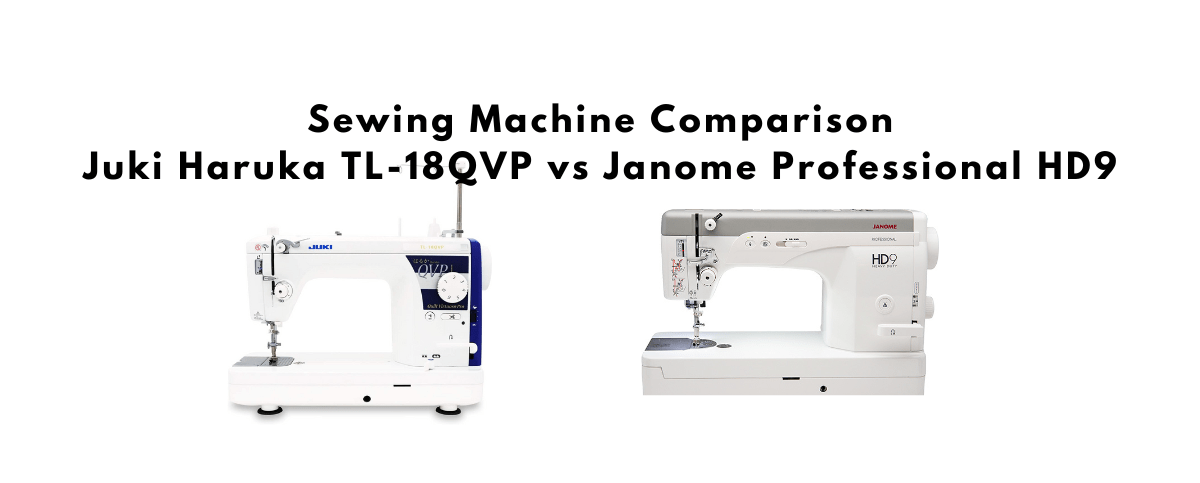If you frequently work with thicker fabrics or require extra strength, consider a straight stitch only machine like the Juki TL18QVP Haruka or the Janome Professional HD9. But how do you decide which one to choose?
They are both popular straight stitch only semi-industrial machines. They appeal to a lot of quilters because they do a fantastic job of free motion quilting, they do straight stitching and they are very fast. In terms of build quality, they’re basically tanks.
These machines are designed as a miniature industrial machine, so they will not be as strong as an industrial machine, but they will have some industrial features, such as the way they thread, the fact that they only do straight stitches, the high speed, and how the bobbin loads in, which will be on the sides.
Read the full reviews of both machines here:
- Juki Haruka TL18QVP Review of the Quilting and Sewing Machine
- Janome Professional HD9 Sewing Machine Review


Differences Janome Professional HD9 vs Juki TL18QVP Haruka
The Professional HD9 from Janome and the TL18QVP Haruka from Juki have many similar features, such as they both are semi-industrial straight stitch machines, that are designed in a sturdy aluminium frame. They both have an automatic needle threader, needle up/down button. It is possible to adjust the foot pressure on both machines and both machines comes with a knee lift and a maximum stitch length of 6mm. Below we’ll look more in detail on what differs between the two machines.
Size and Sewing Space
The Janome Professional HD9 has a little more throat space, so it has a little more workspace to work with. In terms of size the TL18QVP is quite a bit smaller and also weights almost 3kgs less, making it alot more portable and flexible to move around than the Janome HD9.
| Janome Professional HD9 | Juki TL18QVP Hiruka | |
| Machine Size | W498 x H323 x D178 mm | W452 x H350 x D219 mm |
| Machine Weight | 32lbs (14.5 kg) | 25.4Lb (11.5Kg) |
| Work Space | 225 x 140 mm | 215 x 150 mm |
Threading
The Janome Professional HD9 has two thread paths with which you can thread this machine. It can be threaded for standard, normal thread or for thicker thread, and the machine will be able to handle whatever you throw at it. However, I would not recommend wax thread, but it is pretty cool that you can use thicker thread that most home sewing machines cannot handle. The TL18QVP has a handy sub-tension function that helps with balanced thread tension no matter the thread type.
Foot Control
The Juki TL18QVP has excellent foot control feature. This is due to its multi functionality, as it has a little back kick that, when clicked, will cut the thread. This is an optional feature that can be added to the Janome but is not included by default. The foot control on the Janome does not have the cut functionally but is oversized, something we do like.
Sewing Speed
Sewing Speed is very similar on the two machines, with the Janome Professional HD9 being able to sew up to 1,600 stitches per minute and the Juki is up to 1500. Both of the machines have easy to use speed control sliders.
Bobbin System
Both of the machines have a bobbin that is loaded from the side of the machine. A plus for the Janome Professional HD9 is the ability to use a larger, jumbo sized bobbins, giving you up to 40% more thread on the bobbin. Whereas the TL18QVP works with standard size bobbins. Another feature on the Janome is the bobbin winding motor that lets you wind your bobbin while sewing, with the help of a separate motor that the Juki does not have.
Drop Feed
On the Juki the feed dog can be raised and lowered by moving the lever in order to perform free-motion quilting and free-hand embroidery, something that is not available on the Janome.
Price comparison
When it comes to price, again both machines are failry similar. However the MSRP for the Janome Professional HD9 is slightly less with £1,299 compared to the Juki TL18QVP at £1,439. Both machines are easily available and able to be bought from most online retailers such as Amazon with shipping included.
Summary


They are both fast, high-powered machines that are fantastic for quilting and straight piecing. They don’t have a free arm, so if you want to make sleeves and other small items, you’re going to have a difficult time. However, if you make bags or work with thicker materials, you will appreciate both of these machines because they can cut through all of that thickness with ease. Both sewing machines come with a slew of extras, such as walking feet and an extension table. Overall, they provide a very smooth ride and you can’t go wrong with either machine.
